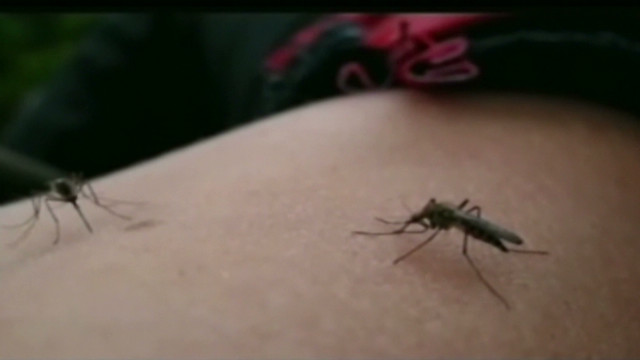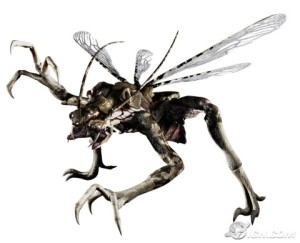Category Archives: Apocalypse
Fly turns honeybees into little zombies
Latest woe is horrific, but is not what’s crashing bee populations
A researcher at Oregon State University has reported Oregon’s first documented case of a “zombie” fly infecting a honeybee, but he doubts that the parasite at the moment poses a threat to the bee, which is a vital pollinator of some of the state’s key crops.
Ramesh Sagili, a honeybee specialist with the OSU Extension Service, stumbled upon a belly-up bee on a sidewalk under a street light on campus in Corvallis one morning in late July, according to a press release Tuesday from OSU. He placed it in a vial in his lab, and four days later seven maggots crawled out of the bee’s neck. Almost three weeks after that, one matured into an Apocephalus borealis fly, commonly called a zombie fly because of the disoriented behavior it is suspected of causing the bees to exhibit at night.
The finding comes amid rising concern about the health of honeybees, which have been hit by a mysterious phenomenon called colony collapse disorder in which adult honeybees disappear from a hive, either entirely or in large numbers. It came to light in late 2006 when beekeepers on the East Coast began to see their honeybee colonies dwindle. The disorder has since spread to other states. A cause has not been determined, but suspects include mites, viruses, malnutrition, pesticides, a lack of genetic diversity, and stress that results from commercial hives being trucked around the country to pollinate crops.
Sagili doubts that the fly is playing a role in the widespread die-off of honeybees, which are crucial pollinators for various Oregon crops, including blueberries, pears, cherries, apples, clover, cranberries and vegetable seeds.
“It’s a stretch to say the fly is correlated to colony collapse disorder,” he said. “At this point, I don’t think it’s a threat. I don’t think it’s at the level where it can depopulate hives in large numbers.”
Earlier this year in a journal article, researchers in California became the first to document that the fly attacks honeybees. They discovered the parasite in honeybees in California and South Dakota, the only states besides Oregon where fly-infected honeybees, or ZomBees, have been reported.
The fly is known to parasitize bumblebees but little is known about its impact on them in Oregon, said Sujaya Rao, an entomologist at OSU.
Sagili hypothesizes that the fly is just now being found in honeybees because it may be trying to branch out from its other hosts when they’re not available. He added that although honeybees are widely studied, it’s possible that scientists just never saw the parasite because they usually preserve their collected bees in alcohol, which would kill the larvae and keep them from popping out.
The brownish-red fly lays its eggs inside the bees and is smaller than a fruit fly, is native to North America and has been found in Canada and states including Alaska, Georgia, Maine, Minnesota, New Mexico and New York, said Brian Brown, the curator of entomology at the Natural History Museum of Los Angeles County and an expert on the parasitic fly.
Brown said the fly has been in Oregon for thousands of years, but it just never has been found in a honeybee in the state until no
AND MAN SHALL FALL! West Nile cases rising; 66 dead

(CNN) — Sixty-six people have died from West Nile virus infections this year, and the number of human cases has grown to 1,590, the U.S. Centers for Disease Control and Prevention said Wednesday.
That’s the highest case count through the last week of August since the virus was first detected in the United States in 1999.
Nearly half of all the infections have occurred in Texas, where officials said later Wednesday that 894 cases have been reported along with 34 deaths.
“Those numbers are going to go up,” said Dr. David Lakey, commissioner for the Texas Department of State Health Services.
Lakey said it looks like 2012 will be the worst year so far when it comes to West Nile virus cases. In 2003, Texas reported 40 deaths because of the virus, and health officials believe they will surpass that number this year.
All lower 48 states are now reporting West Nile activity, and 43 states have reported at least one person infected with the virus.
More than 70% of all West Nile virus cases in the United States are found in six states: Texas, South Dakota, Mississippi, Oklahoma, Louisiana and Michigan, according to the CDC.
While the CDC said these are the highest number of cases reported by the last week in August since the disease was first recorded in 1999, it’s not the highest number the country has seen. In 2003, the United States had 9,862 reported cases of West Nile virus, and in 2002 there were more than 4,100 cases and 284 fatalities.
In more than half the current nationwide cases, West Nile has led to neuroinvasive disease — serious illnesses like meningitis, encephalitis or virus-associated paralysis. About 10% of these cases can be fatal, according to the CDC, and a high proportion of those who survive can be left with longstanding neurological problems.
Older people are more vulnerable to severe illness from West Nile. So far, the median age among those with neuroinvasive disease this year is 58. In Texas, nearly two-thirds of all cases are in people older than 50.
Health officials do not yet know why there are more cases this year than in recent years.
Based on previous experiences with floods and hurricanes, health officials do not believe Hurricane Isaac will have a major impact on this year’s outbreak.
Mosquitoes that spread the virus breed in small nutrient-rich pools of water, such as the water found in old tires, so a large rainfall event or flooding usually washes out those small pools and eliminates breeding sites, said Dr. Lyle Petersen, who heads the CDC’s Division of Vector-Borne Infections.
But after the water recedes, there’s always the possibility that new small pools of water will form.
Petersen urged the public to take proper precautions to prevent getting sick regardless of whether they live in a state with high or low case counts.
To reduce your risk of exposure to mosquitoes and to prevent their breeding sites:
— Drain all standing water from flower pots, old tires, clogged rain gutters, etc., where mosquitoes breed.
— Use an insect repellant that contains DEET, picaridin or oil of lemon eucalyptus.
— Also wear long sleeves and long pants to protect your skin when you’re outside.
— Stay indoors at dusk and dawn because that’s when mosquitoes are most active.
Doomsday 2012 Fact Sheet
 There is widespread and unnecessary fear of doomsday on December 21, 2012. Some people worry about a Maya prophesy of the end of the world, others fear a variety of astronomical threats such as collision with a rogue planet. Opinion polls suggest that one in ten Americans worry about whether they will survive past Dec 21 of this year, and middle-school teachers everywhere report that many of their students are fearful of a coming apocalypse. Following are brief facts that address these doomsday fears.
There is widespread and unnecessary fear of doomsday on December 21, 2012. Some people worry about a Maya prophesy of the end of the world, others fear a variety of astronomical threats such as collision with a rogue planet. Opinion polls suggest that one in ten Americans worry about whether they will survive past Dec 21 of this year, and middle-school teachers everywhere report that many of their students are fearful of a coming apocalypse. Following are brief facts that address these doomsday fears.
Mayan Calendar: The Maya calendar, which is made up different cycles of day counts, does not end this year. Rather, one cycle of 144,000 days (394 years) ends and the next cycle begins.
Mayan Prophecy: The ancient Maya did not predict the end of the world or any disaster in December 2012. Such doomsday predictions are a modern hoax.
Planet Nibiru: Nibiru is probably the minor name of a god found in ancient Mesopotamian writing. There is no planet named Nibiru, and the fictional books by economist Zecharia Sitchin about a civilization on this planet are a hoax.
Rogue Planet Headed for Earth. For the past decade there have been reports of a rogue object (Planet X, or Nibiru, or Hercubolus, or even Comet Elenin) that will collide with Earth in December 2012. These claims are not true. If such a threatening world existed, it would be one of the brightest objects in the sky, and astronomers would have been tracking it for years. If it existed, its gravity would be distorting the orbits of planets, especially Mars and Earth. Astronomers know that it does not exist.
Planet Alignments: There is no alignment of planets in Dec 2012. There is an approximate lining up of the Earth and Sun and the center of our Galaxy in late December, but this happens every year. In any case, planet alignments have no effect on the Earth.
Pole Shift: There is nothing strange this year about either the magnetic poles or the rotational poles of the Earth. The magnetic polarity changes every million years or so, but that is not happening now, and it probably takes thousands of years when it does happen. A sudden change in the rotational axis has never happened and is not possible. If there were any change in the Earth’s rotation, it would be instantly apparent by failure of our GPS systems.
Increasing Disasters. Our planet is behaving normally in 2012, although we see more and more news stories about natural disasters. There has been no increase in earthquakes or volcanic eruptions. There has been an increase in extreme weather, including both droughts and floods, which are partly attributable to global warming, but this has nothing to do with a 2012 doomsday.
Solar Outbursts: The Sun’s ongoing 11-year activity cycle is expected to peak in 2013, not 2012. Solar outbursts (flares and CMEs) can damage orbiting satellites but will not hurt us on the surface. The strength of the 2013 solar maximum is predicted to be lower than average, not higher.
Bunker Conspiracy: Accusations of a massive government cover-up are nonsense. No government could hide an incoming planet or silence hundreds of thousands of scientists. Rumors that huge bunkers have been built in the U.S. or elsewhere to shelter the elite are lies. Apparently a few people are building private shelters, but their fear of 2012 is misplaced and they are wasting their money.
Scaring Children: The group most vulnerable to doomsday claims is children. Teachers report that many of their students are frightened and some are even considering suicide. This is the most tragic consequence of the 2012 hoax.
The End of the World: The idea of the sudden end of the world by any cause is absurd. The Earth has been here for more than 4 billion years, and it will be several more billion years before the gradual brightening of the Sun makes our planet unlivable. Meanwhile there is no known astronomical or geological threat that could destroy the Earth.
Cosmophobia: Many young people write to me that they are scared of astronomy. When they read about some new discovery, the first thing they think is that it might hurt them, even if it is happening in a distant galaxy. There is no reason for such fears, which I call cosmophobia (fear of the universe). This rash of concern seems to be the result of too many conspiracy theories and sensational stories featured on the Internet and irresponsible news outlets. Astronomical objects are so distant that they cannot threaten the Earth. Please don’t be afraid of the Sun or the planets or comets or asteroids. The universe is not your enemy.

